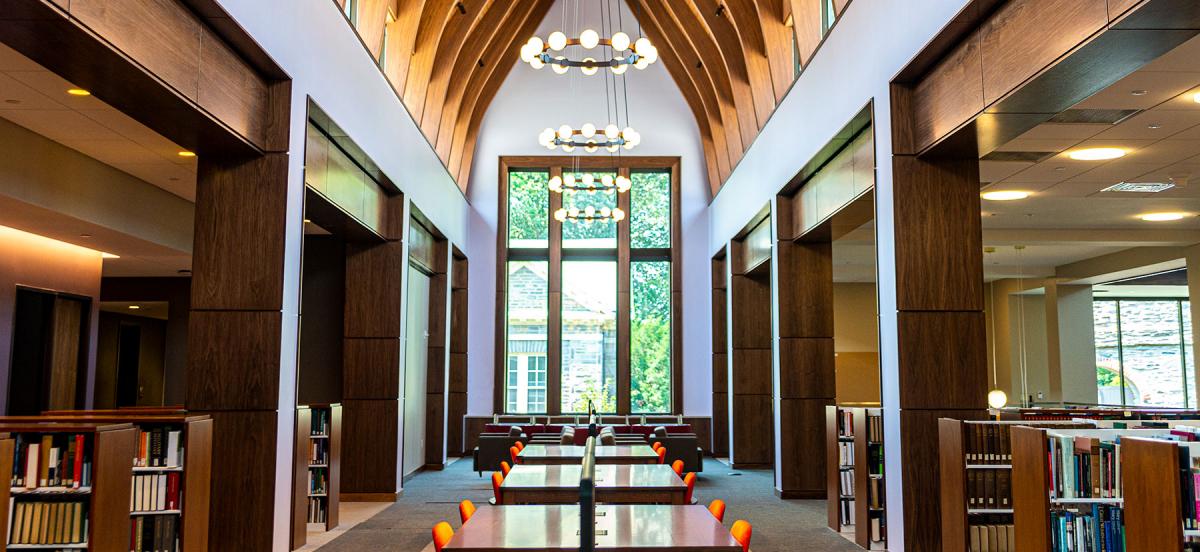A New Era for Haverford College Libraries

Lutnick Library preserves the historic spaces of Magill, but includes many enhancements and advancements, such as technological robustness and an abundance of natural light. Photo by Patrick Montero.
Details
After an 18-month renovation, Haverford’s main library, now called Lutnick Library, re-opens with the new school year, ushering in a new era for scholarship at the College.
When Haverford was founded in 1833, the library—which students were only allowed to visit for one half hour a week—was just one room in Founders Hall with holdings of only 770 scholarly works and a handful of periodicals. Over the 186 years since, the College’s libraries have grown to include several buildings (including Union Music Library, White Science Library, and the Astronomy Library), a world-class Quaker and Special Collections, and a main location, previously known as Magill, which collectively provide access to more than a million print and electronic volumes with additional access to 2.5 million volumes though the Tri-Co relationship to Bryn Mawr and Swarthmore Colleges. As the 2019/20 school year dawns, the College is unveiling a newly remodeled library worthy of its growing holdings and myriad uses—an innovative library for the 21st century.
Following an 18-month renovation, the old Magill space has reopened as the Allison and Howard Lutnick Library, a space that enhances engagement with the library’s collections while vastly improving and supporting the core elements of its programming. It is named in honor of Howard W. Lutnick ’83, whose gift of $25 million funded most of the renovation. (The heritage wing of the library that faces Founders Green retains the Magill name.)
“Magill, and its predecessors, served the College community well for over 150 years, but just as learning on college campuses has evolved, so, too, have libraries and how they serve their communities,” said Librarian of the College Terry Snyder. “In recent years, Magill’s best functional capacity was that it stored our circulating collections and that it served as a good study space for some, though not all, students. Lutnick Library offers the best of Magill while vastly improving and supporting the core elements of the libraries’ programming.”
The new library preserves the historic spaces of Magill, such as the two-story Philips Wing and the recognizable gothic façade on Founders Green, but includes a plethora of enhancements and advancements. Quaker and Special Collections is now housed in an open space with temperature and humidity control needed for preservation and long-term access of its holdings, and it has its own classroom in which to spotlight them. The Nan and Bill Harris Digital Scholarship Commons, which includes group study rooms, computers and other technology, and a flexible open programming area, now gives a physical space to digitally informed research. There are more and better locations for instruction and events, including nine reservable group-study rooms, two technologically equipped seminar spaces and a video-viewing room, a main gallery, and multiple exhibitions spaces, which faculty are already incorporating into their syllabi. (The inaugural exhibition, which opens Oct. 7, will feature the David Wertheimer ’77 Collection of Early Printed Books and is curated by Alex Stern ’20.)
“Equally important,” said Snyder, “the new Lutnick Library is easily navigable, offers a strong blend of learning spaces, and incorporates a significant infusion of technological robustness, natural light, and beauty.”
For the first time, the library offers areas that are open 24-7 all year round, not just during finals. They include the Open Reserves Reading Room, which gives students access to all course-required texts; three group study rooms; gender-neutral, fully accessible bathrooms; and a cafe with indoor and outdoor seating.
“In all areas, from traditionally quiet research and study to more collaborative and active learning, the spaces in the new library will be qualitatively superior, will advance the College’s mission of academic excellence, and will serve the College well for generations to come,” said Snyder.
The renovations move the library from a location to simply access books and information to a learner-centric space. For example, the extended Radio Frequency Identification technology in the collections not only gives students more convenient access to books through self-check kiosks, but also allows the libraries to redeploy some of their approximately 125 student workers from collection-management roles—checking out books, restocking shelves—into core functional areas, such as acting as a peer liaison to their fellow students or contributing to digital scholarship or special collections work.
“The centrality of the student—in the types of collaborative spaces, in the critical engagement with a range of texts, in the enhanced roles of student colleagues, and in the programming—represents an important shift,” said Snyder.
For the building’s lead donor, these were all improvements necessary to elevate the space to the level of the research, scholarship, and teaching being done inside.
“For us not to have a great, modern library was just not Haverford,” said Lutnick. “It wasn’t fair to the students, and it wasn’t fair to who we are. So now people will walk into the new library and say, ‘Wow, this is great.’ They’ll go to the athletic center, and say, ‘Wow, this is great.’ They’ll go to the new dorms, and say ‘Wow, this is great.’ And then they will leave the campus thinking, ‘This is idyllic. What’s better than this?’ And the answer is: Nothing.”
Student first impressions:



